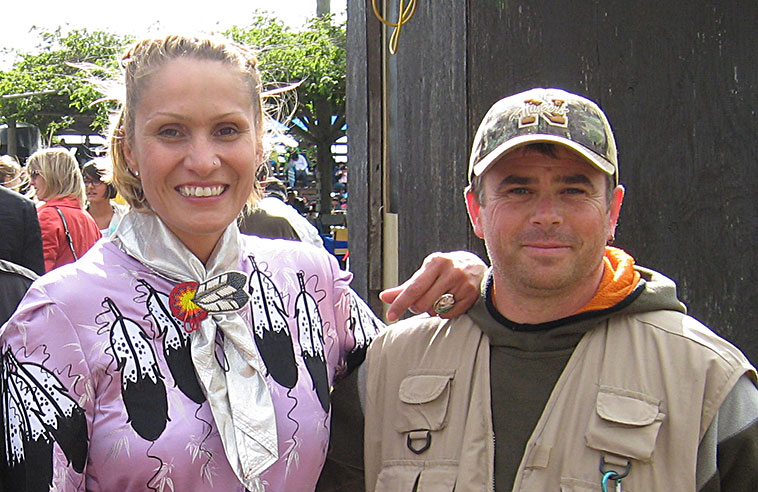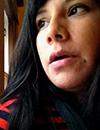
“My mom is the one who made a prayer for every jingle that we sewed on that dress. When I dance, I’m actually dancing with all of my mother’s prayers.”
Republished with permission from Anishnabek News 2014 Pow Wow Guide.
 TORONTO — She grew up with a parent who survived the Indian Residential School system, and remembers as a child trying to make sense of what happened to her mom.
TORONTO — She grew up with a parent who survived the Indian Residential School system, and remembers as a child trying to make sense of what happened to her mom.
“Growing up with a survivor you get the sense that something’s wrong,” says Cree filmmaker Jules Koostachin. “I feel I was robbed from having a healthy childhood.”
Not only did she feel her mother’s pain, she also grew up not knowing much about her heritage. The experience of attending her first pow-wow at age 19 triggered a yearning to learn more about First Nations culture and traditions.
“Growing up I wasn’t exposed to the pow-wows but I knew there was something out there that was beautiful and strong,” says Koostachin.”When I first heard that drum, it resonates, you feel it inside.”
Eventually that resonance would lead to Jingle Dress —First Dance, a documentary about her journey to become a jingle dress dancer. Filmed over a 10-year period, the documentary shows Koostachin take her first step onto the pow-wow grounds. It is a film about three generations of women who have all been impacted by the residential school system.
“The film process is also about me trying to understand this whole movement around ‘to save the child, you have to kill the Indian,’” says Koostachin, whose mother Rita Okimawininew attended residential school from the ages of 5 to 16.
Okimawininew attended two residential schools, one of them St. Anne’s Residential School in Fort Albany on the James Bay coast. Koostachin was raised not only by her mother but by her grandparents in Moosonee. Later the family would relocate to Ottawa.

Koostachin collaborated with documentary producer James Buffin and together they began the filming process in 2003.
Buffin, not only directed and produced the documentary but was a key witness to Jules’ experience in the film. It was a learning experience for both and recorded as part of the documentary.
“She really wanted to respect the protocols but she didn’t know what the protocols were, so she had to find guidance,” Buffin recalls.
Cultural advice came from author Lee Maracle, who guided Koostachin and Buffin through the filming process.
Koostachin prayed, did a fast and held a feast and giveaway for her dress.
“The jingle dress is for healing,” she says.“There are so many things you have to do so that the dress can become your prayer.”
It seemed apt because First Nations consider the jingle dress as a medicine dress, a tool for spiritual healing.
E.J. Kwandibens, a close friend and regalia maker from Toronto helped Koostachin make her first dress, and his nine-year-old daughter Sagatay taught Koostachin how to dance jingle.
Now 41, and recruiting for the Indigenous visual culture program at OCADU (formerly the Ontario School of Art and Design), Koostachin says being in front of the camera made her feel “vulnerable and exposed”.
But she continued her journey to tell her story on film, traveling to Eagle Lake First Nation in northwestern Ontario near Whitefish Bay where some say the jingle dress dance originated. She held her initiation ceremony in 2009.
“My mom is the one who made a prayer for every jingle that we sewed on that dress. When I dance, I’m actually dancing with all of my mother’s prayers.”
The film helped break a long period of silence between Koostachin and her mom.
“There is still pain but it’s easier to deal with now.”
The film shows Koostachin visiting the Woodland Cultural Centre in Brantford, formerly known as the Mohawk Institute Residential School. It was Koostachin’s goal to try to gain greater insight into what her mother went through.
Jingle Dress – First Dance was screened for the first time March 27-30 in Edmonton at the final national event staged by the Truth and Reconciliation Commission.
Jules Koostachin is working with Big Soul Productions putting the final touches on her reality series askiBOYZ, which airs on APTN this fall.
The show features her sons Asivak, 19, and Mahiingan, 17. She also has twins Pawaken and Tapwewin, 7.
For more information visit jingledress.ca
CHECK OUT MUSKRAT’S INTERVIEW WITH JULES KOOSTACHIN ON ASKI BOYZ!
 James Buffin, filmmaker Jingle Dress – First Dance
James Buffin, filmmaker Jingle Dress – First Dance
James Buffin is a filmmaker with over 25 years experience, working on movies, tv shows, commercials, music videos and documentaries shooting across North America, South America, Asia and the South Pacific. The theme of his current work is disaster/recovery, both environmental and personal. Current projects include a feature length documentary about becoming an aware survivor of childhood sexual abuse. Having taught for many years with organizations like Planet In Focus, LIFT Toronto and Workman Arts, he recently expanded his company, Veritus Pictures, to include video workshops in Toronto’s East End.
 Jules Koostachin
Jules Koostachin
Born in Moose Factory, Ontario, Jules Arita Koostachin was raised by her Cree speaking grandparents for part of her childhood in Moosonee, as well as her mother in Ottawa. Jules is from Attawapiskat First Nation, and she is currently living in Sudbury with her family. In 2010, she completed her Masters in the Documentary Media Program at Ryerson University and while a student she was awarded the Award of Distinction for her thesis work, and the Ryerson University Gold Medal for academic achievement. Over the years, Jules has been working in several different capacities both in the arts and in the field of social work, her recent focus of work is on using media as a tool of empowerment by shedding light on important Indigenous issues









